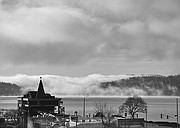It's turkey time, which means rain and snow for fixins
Another big wind storm roared through North Idaho last Monday with winds over 50 mph in many locations. Gusts hit 56 mph at Coeur d’Alene Airport, 59 at Cliff’s station and 48 at Spokane International Airport.
However, a station in Athol reported a gust of 72 mph, just 2 short of the equivalent of a Category 1 hurricane. As I mentioned last week, on Nov. 16, 2015, the historic wind storm had gusts of 60 mph at Cliff’s station and a 101 mph gust at Colburn in Bonner County.
We also had our first snowfall with over an inch of accumulation in Coeur d’Alene on Friday. It looks like we’ll be seeing rain and snow over the Thanksgiving holiday weekend, so be careful if you’re going to be out of the roadways.
The overall weather pattern is looking very favorable for snow in early December as a series of storms will be moving in from the Gulf of Alaska.
GEOMAGNETIC STORMS
Since late 2019, the sun has been in a solar minimum cycle with generally low sunspot activity. However, our closest star appears to be waking up as there has been a recent series of geomagnetic storms.
In early November, several coronal mass ejections headed toward Earth. One storm was overtaken by another eruption, which was termed a “cannibal CME.”
A coronal mass ejection is a large release of plasma and accompanying magnetic field from the sun’s corona, which is the outer layer of its atmosphere. They will often follow solar flares and are released into the solar wind. The number of CMEs will vary per year and most will have only minor effects on our planet.
However, some of these solar flares have been strong. For example, there was one that literally shut down the Hydro-Quebec Power Plant in Canada on March 13, 1989. The solar storm was so intense that the Northern Lights could be seen as far south as Florida and Cuba. Some people thought a nuclear strike was in progress.
On Aug. 4, 1972, a strong solar flare knocked out long-distance telephone communication across Illinois.
The most spectacular super solar flare was witnessed by England’s foremost solar astronomer, Richard Carrington, on Sept. 1-2, 1859. He first noticed a huge group of sunspots on Sept. 1 and then described “two patches of intensely bright and white light erupting from the sunspots” before they disappeared.
On that September night, tremendous auroras of red, green and purple erupted across the Earth. The auroras were so brilliant that one could read a newspaper at night and it could be seen as far south as Cuba and Hawaii.
The auroras were so bright that their glow awoke gold miners in the Rocky Mountains. Telegraph systems all over North American and Europe stopped working and some generated sparks and fires.
Many scientists say that if that type of event were to happen today, the world’s high-tech infrastructure, which includes major satellites, would be severely damaged and perhaps be ground to a halt. Damage estimates from a Carrington-type event today would range between at least $500 million to over $2.5 trillion.
One scientist says there is only a 12 percent chance of a solar superstorm hitting Earth in the next 10 years. However, there was a huge solar storm in July 2012 that narrowly missed our planet.
During the 2010s, we were in a solar “minima” cycle as sunspots, which are storms on the sun, were minimal. However, we’re in a new cycle and the sun seems to be waking up.
This accelerated pace of increasing sunspots, according to scientists, is a sign that the next solar maximum cycle is fast-approaching. Forecasters expect this cycle, which swings like a pendulum between high and low sunspot numbers every 11 years, to reach its next high point somewhere between late 2024 and the middle of 2025.
Sunspots are storms on the sun and during the height of a cycle, its magnetic poles will usually flip as the North Pole becomes the South Pole and vice-versa.
The last solar cycle, which was number 24, began in late 2008 and ended in late 2019. During that time, there were 914 days without a single sunspot on the sun. Since 1855, the cycle with the most days without sunspots occurring in the early 1900s was Solar Cycle 14 with 1,007 days.
According to an article on sciencedaily.com, the National Center of Atmospheric Research is predicting this current Solar Cycle 25 will peak with a number between approximately 210 to 260 sunspots. This would be an extremely active cycle if the forecast is accurate.
With the peak of the current cycle not expected for at least three years, the chances for us to see more instances of the “Northern Lights” are certainly much higher.
• • •
Contact Randy Mann at randy@longrangeweather.com



